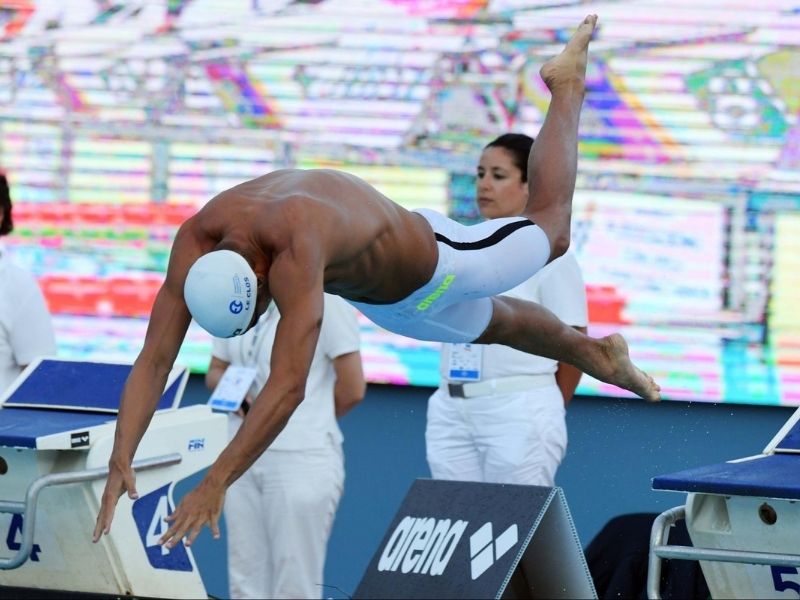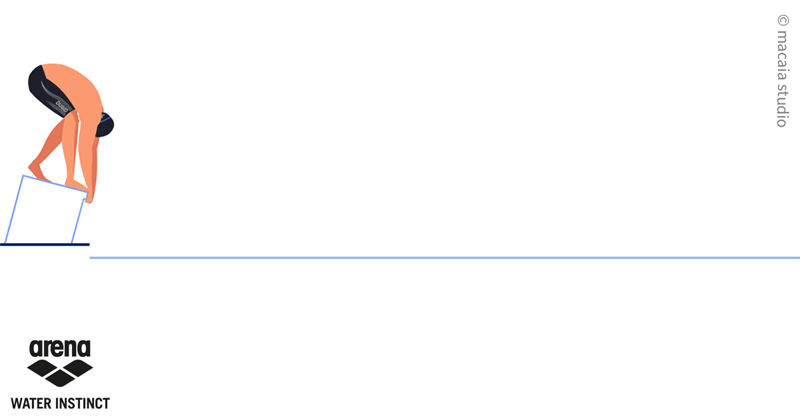Starting Block Drills and Pointers for Faster Turns
Along with a proper warm-up routine and a good training program, the start and turn are vital for any swimmer, whatever their standard. That is why we have decided to give you a few tips to improve both your start and freestyle turn.
Whether you are a sprinter or a long-distance swimmer, good starts and turns will help you quickly reach your top speed. Today, we will go over the advantages of using the track start over the grab start. After that, we will provide some starting block drills for you to practice. Then, we will explore turning techniques and give you a few tips you can implement in your training.
Initial Speed Is Generated From Good Starts and Turns
Similar to track athletes on the starting line, swimmers need a good block start to begin an event. After that, they use turns to push off the wall and begin the next lap. Both the start and turn are areas where you can utilize your legs to generate tremendous amounts of force, allowing you to quickly reach maximum velocity in the water.
It is important to get up to speed quickly before you begin the underwater phase of your lap. According to an article published in FINA, this is the fastest part of a lap because swimmers reduce drag when streamlining and utilize strong body muscles in their underwater kick.
However, all that speed isn’t generated from your streamline and dolphin kick alone. You gain most of your initial speed from pushing off the block or the wall. Good force application from your legs is key to developing a strong start and turn, and it will give that boost of speed you need at the beginning of each lap.
The Grab Start vs. The Track Start

There are two types of starts in swimming: the grab start and the track start. For the grab start, you place both your feet on the edge of the starting block about shoulder-width apart. For the track start, on the other hand, one foot is placed at the front of the starting block and the other behind it on a small pad ready to push off.
A study published in the International Journal of Exercise Science finds that the track start has an edge over the grab start. The track start allows for improved balance in the start position, faster reaction time to the start signal, and a more powerful drive phase off the block.
Balance is where a good start begins. If you are off-balance when the start signal goes off, you will have poor reaction time and less power as you push off the block. You can achieve proper balance by focusing on correct body position while you train. In the track start, you have a front foot and back foot to shift your weight between to find a comfortable balance point for your starting position.
Your reaction time will be better with the track start. The body position of the track start allows for your initial movement to begin off your back leg. In the grab start, on the other hand, your first move is generated using your arms. The track start is preferable because your legs are much stronger than your arms so you can exert force more efficiently off the block, resulting in a better reaction time.
You will have more power from the track start because your legs begin the drive phase and have more time to exert large amounts of force onto the block. Plus, you can achieve a higher hip position in the track start, allowing you to enter the water at an optimal angle.
Tips for a Good Track Start
Here is what you should focus on to carry out a good start:
- An efficient push off the starting block
- The best possible entry into the water
- The fastest possible thrust through the water
To achieve all this, you need an excellent set position on the starting block. Follow these four key rules:
- Keep your hips up with a slight bend in your front knee.
- Look downward.
- Extend your arms perpendicular to the starting block.
- Place your back foot on the starting block behind the line of your hips.
How to Adapt the Track Start From a Conventional Block

Not all swimming pools are equipped with the very latest starting blocks (i.e., with a rear pad), so you need to know how to adapt your position to any kind of block. If you are using “conventional” blocks:
- Check your elbows. Since you cannot keep them straight and perpendicular to the starting block, bend them and make sure they are pointing backward, not outward.
- Your toes should point forward.
- Your feet should be just behind your hips and not directly in line with each other.
- Your chest should rest against your thigh.
How to Execute the Perfect Dive
Now you are almost ready. To make sure you execute a perfect dive, check that right after pushing off:
- Your elbows are thrust forward followed by your hands; they must not be in front of your face at the start.
- Your chin and chest are pushed forward. Do not push upward; make sure your shoulders are raised and your back is horizontal.
- Your chest is low and your back flat; this will allow you to push off as powerfully as possible with your rear leg.
3 Starting Block Drills
Try this sequence of start drills to learn the proper position. Take up your position on the starting block and practice the following:
- In the grab start position, bend your legs and keep your chest and back flat. With your arms extended and parallel to the water, make sure you are looking downward and your hips are not too high. Push off the block and focus on how you enter the water.
- In the same position as described above, move one foot backward onto the rear pad and raise your hips. Find a comfortable balance between the front leg and the back leg. Push off and remain focused on the position of your hips and head as you enter the water.
- Starting from the position referred to above, move your arms backward bending your elbows. Try to keep a straight back. Push off and try not to raise your body too much as you dive into the water.
As you practice these drills, you will begin to develop a feeling for proper body position throughout your start. Remember to always focus on driving through your legs to generate the necessary power going into your dive. When you are in the air, envision your body at a good degree angle and in a straight line. A good entry is all a matter of angles, so you should focus on diving into the water at about a 40-degree angle.
5 Pointers for Faster Turns

Now that you have found an ideal starting position, try and improve your turn. Here are five things to focus on:
- Your head should follow your hand. You should start to tuck your head down and curl your back while you are making your last stroke.
- Raise your hips. Curl your head underwater, push your shoulders downward, and push off folding your hips upward as powerfully as possible.
- Curl your head underwater. At the end of your last stroke, immediately rotate your palms downward, lower your head, and curl it underwater to help your body rotate.
- Keep your knees up at the surface. The biggest mistake is to keep your heels up and bend your knees too quickly, thereby creating huge water resistance.
- Push off the wall. The thrust technique is the same as when jumping out of the water. Keep your feet level with your hips, steady your upper body, and push with your legs right up to your shoulders.
Focus on these tips during your next trip to the pool. In the meantime, you can work toward a faster turn by improving the flexibility of your hips, back, and core.
Practice Makes Perfect
When you start practicing your starts and turns, do not worry if you make mistakes in the beginning; that is quite normal. Making mistakes is the only way to improve, so do not give up!
Implement some of the drills and tips mentioned above into your next training. Keep at it, and you will see improvement in your starts and turns. Then, you will start your races and laps with the speed necessary to improve your swim times!
Make sure you are well-equipped for training so you can forget about the equipment you are wearing and focus solely on your form. Visit Arena Sport for all your swimming needs, whether you swim for recreation or you are an elite competitor.
Written by:
Harrison Howarth
Harrison is a freelance writer with a background in competitive aquatic sports. His love for water polo and swim, combined with his passion for writing and education, drives him to continue teaching and inspiring individuals to participate in aquatics.







